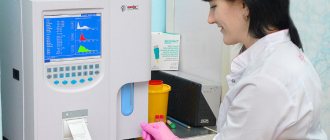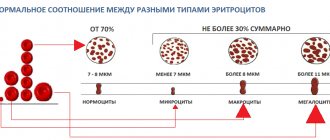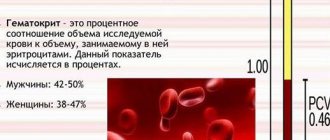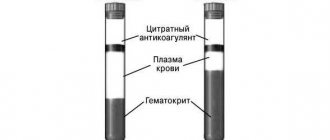Hemoglobin and hematocrit are increased in smokers, people living in high altitudes, and athletes, especially those using erythropoietin injections. Diseases with such changes can be congenital (erythrocytosis, abnormal forms of hemoglobin), acquired - tumors, heart defects, chronic diseases of the lungs and kidneys. The cause is also dehydration due to vomiting, diarrhea, burn disease, and diabetic coma.
With an increase in hemoglobin and hematocrit, blood thickening occurs and the rate of formation of clots (thrombi) increases. The consequences are heart attack, stroke, pulmonary thromboembolism. To prevent complications, it is important to increase the consumption of drinking water (35-40 ml per kg of body weight); complex treatment includes Curantil, Plavix, and Aspirin.
Increased hemoglobin and hematocrit: what the indicators indicate, what does this mean
An increase in hemoglobin and hematocrit indicates blood thickening. The first indicator is the protein contained in red blood cells, and the more there are, the higher the hemoglobin level. Hematocrit is the percentage of all cells (mostly red blood cells) and the liquid portion of the blood. Its growth occurs in two cases - accelerated formation of cells by the bone marrow (less often, delayed destruction) and lack of fluid due to dehydration.
The norm for men is that the blood should contain 135-160 g/l of hemoglobin and 39-51% hematocrit, for women the figures are 120-140 g/l and 35-47%, respectively. In children, normal values change with age (see table).
| Age | Hemoglobin, g/l | Hematocrit, in% |
| From birth to 7 days | 135-215 | 42-66 |
| From 1 to 4 weeks | 125-180 | 35-63 |
| From a month to a year | 100-140 | 30-39 |
| From one to 3 years | 105-145 | 33-39 |
| From 3 to 7 years | 110-150 | 33-40 |
| From 7 to 12 years | 115-155 | 35-45 |
If red blood cells are still high
High red blood cells, hemoglobin and hematocrit occur during the following processes in the body:
- tumor division of erythrocyte progenitor cells in the bone marrow;
- hereditary diseases with an increase in red blood cells (erythrocytosis) or the formation of abnormal forms of hemoglobin (hemoglobinopathy);
- oxygen starvation in respiratory, heart failure;
- tumors of the kidneys, adrenal glands;
- dehydration.
A slight deviation from the norm in a larger direction occurs in smokers and people living in high altitudes. Such changes occur in professional athletes, especially those who inject Erythropoietin before competitions.
Lymphocytes are additionally increased
Increased hemoglobin, red blood cells and hematocrit, as well as lymphocytes occur in all types of diseases with blood thickening. If the leukocytes in the blood are represented mainly by lymphocytes, then this is a sign of acute or chronic leukemia (blood cancer). Additional factors may be a viral infection, rheumatism, or a focus of purulent inflammation.
Norm
The hematocrit norm differs depending on age and gender. In newborns, the rate is considered high and the norm is 42% - 65%. As one grows older, it decreases; in older people, a minimum level of hematocrit is observed. For adults aged 18-65 years, the norm is:
- For men - 41% - 53%.
- For women - 36% - 46%.
Deviations from the norm can be observed during pregnancy. From about 20 weeks, the indicator decreases due to an increase in the amount of liquid part of the blood for physiological reasons. After childbirth, the hematocrit quickly returns to normal values in the absence of pathologies.
Deviations towards increasing hematocrit are recorded:
- In smokers, due to oxygen starvation of tissues, which leads to an increase in the production of red blood cells.
- When rising to a high altitude, the production of red blood cells increases due to the body's adaptation to the reduced oxygen concentration in the air.
- For stress and traumatic shock, which is characterized by intense pain.
- When taking corticosteroid drugs and diuretics,
Deviations towards a decrease in hematocrit are recorded:
- With prolonged immobility.
- When taking antiplatelet agents and anticoagulants that thin the blood.
- Against the background of high fluid consumption.
- For chronic alcoholism.
Why are high rates dangerous?
Blood thickening
Blood thickening with increased hemoglobin and hematocrit is dangerous due to accelerated formation of blood clots. They can clog blood vessels of any location, the most critical being blocking the lumen of the arteries of the heart and brain. A heart attack or stroke develops, often resulting in death. Also, a threat to life occurs with massive thrombosis of the pulmonary arteries.
With widespread thrombus formation, clotting factors are quickly consumed. Therefore, patients have a tendency to bleeding - nasal, uterine, gastrointestinal, hemorrhoidal.
What happens inside the body
Physical exhaustion, surgery, smoking addiction, use of potent drugs, malignant neoplasms - each of these reasons leads to a situation where the patient has an increased or decreased hematocrit. If the indicator is changed downward, then the blood does not capture a sufficient amount of oxygen, and the immune system is not able to fight pathogens. A shift in the actual hematocrit level results in excessive blood thickness. In addition to the negative consequences described above, there is an increased likelihood of heart attack and blood clots.
On a note! There is no single standard value for hematocrit level. The indicator is calculated taking into account a person’s age, gender, living conditions, and the presence of chronic diseases.
Blood taken from a person is placed in a test tube and sent to a centrifuge. Under external influence, formed elements are released within 2-4 hours. The laboratory assistant analyzes their relationship, recording observations on paper.
Increased hemoglobin and hematocrit in women and men: causes
The main causes of increased hemoglobin and hematocrit in men and women can be divided into several groups:
- heart and vascular diseases - widespread atherosclerosis, heart defects, heart failure, abnormalities in the structure of blood vessels with mixing of venous and arterial blood (malformations);
- bronchopulmonary pathologies - chronic pneumonia, bronchitis with bronchospasm, severe bronchial asthma;
- metabolic disorders - diabetes, obesity;
- night apnea during sleep (stopping breathing when snoring);
- tumors - cancer of the kidneys, liver, adrenal glands, cerebellum, pituitary adenoma and cyst, hormonally active ovarian tumors;
- renal diseases - narrowing of the renal artery, dropsy and cysts, glomerulonephritis, transplanted kidney;
- splenectomy.
Most diseases occur with respiratory failure, in response to which the kidneys intensively produce erythropoietin. It leads to increased division of bone marrow cells. With tumor processes in the bone marrow, this process occurs uncontrollably.
If the hematocrit is increased in an adult, then the cause may also be a deficiency of the liquid part of the blood when:
- burn disease;
- diarrhea due to infections or intestinal diseases (including colitis, obstruction);
- transition of fluid into the abdominal cavity (peritonitis, ascites);
- diabetes insipidus (impaired reabsorption of water in the kidneys);
- comatose state due to extremely high sugar in diabetics.
A temporary increase is typical for the use of hormonal drugs (Prednisolone, Testosterone), the administration of Erythropoietin, as well as the abuse of diuretics and laxatives.
Increased hematocrit
Many people are interested in the question of when the hematocrit is increased, what does it mean. First of all, the indicator increases with the accelerated production of red blood cells by the bone marrow. An increase in the size of red blood cells can also lead to deviations above normal. This occurs in various pathological conditions, namely:
- Primary erythrocytosis, which occurs against the background of overactive production of red blood cells, most often indicates tumor processes in the bone marrow.
- Secondary erythrocytosis is associated with pathologies of the respiratory and cardiovascular systems, in particular, it develops with respiratory failure or heart disease.
A decrease in plasma volume, and, consequently, an increase in hematocrit may indicate the development of peritonitis, leukemia or kidney pathologies. This also happens with extensive burns. The cause of dehydration is often uncompensated diabetes mellitus.
Erythrocytosis at the initial stage, when the hematocrit is slightly increased, is asymptomatic. In most cases, abnormalities are discovered accidentally during a routine medical examination. But with a significant increase, it is discovered by chance, when taking a blood test for other reasons. Only with a significant increase in hematocrit do warning signs arise:
- Pain in joints and muscles.
- Shortness of breath, weakness and increased sweating.
- Dizziness.
- Increased pressure.
Since symptoms are not specific, if they appear, you should undergo a full examination in order to make a correct diagnosis. Treatment can only be successful if the cause of the increase in the number of red blood cells in the total blood volume is established.
High hematocrit and high hemoglobin: how to stabilize the indicators
In order to reduce high hematocrit and hemoglobin levels outside of illness, it is enough to increase the volume of drinking water. It should be at least 35-40 ml per 1 kg of weight. It is useful to increase the proportion of vegetables, fruits, and berries in the diet, reduce the consumption of infusions, spicy, fatty foods, alcoholic beverages, and coffee. It is important to quit smoking. Healthy people are encouraged to become blood donors.
If the hematocrit is increased in an adult due to illness, then treatment includes drugs that reduce blood clotting - Curantil, Aspirin, Plavix. Radical therapy is based on the underlying disease. Symptomatic relief is provided by bloodletting and the introduction of plasma-substituting solutions in droppers.
Increased hematocrit and hemoglobin mean thick blood, there is a risk of blockage of blood vessels with blood clots. The causes include bone marrow diseases, tumors, cardiovascular, pulmonary and renal pathologies.
Symptoms are not always pronounced
Blood, losing the normal level of red blood cells, will cause the development of primary symptoms. The patient complains of fatigue, weakness, and headache. Within 3-5 days, dry mouth and other symptoms will appear:
- tingling in fingertips;
- cold hands and feet;
- feeling of heaviness in the legs;
- depressed emotional state;
- drowsiness;
- loss of coordination of movements.
Secondary symptoms of high hematocrit include hypertension, fainting, nausea, and inability to concentrate.
On a note! Lack of proper attention to the problem on the part of the doctor leads to the formation of blood clots in the arteries, heart attack, acute oxygen starvation, and frequent bleeding.
Diagnostic course and treatment
A general blood test is taken every six months for preventive purposes. Its results make it possible to determine the hematocrit level even in a situation where symptoms are not expressed. A coagulogram will help confirm or refute the doctor’s suspicions. The results of blood tests reflect the rate of clotting. The last test is APTT, which reflects the ratio of blood cells. If the information collected does not allow a diagnosis to be made, the patient is referred to specialized medical specialists.
Having dotted all the i's, the doctor proceeds to drug treatment. The patient is prescribed a course of antiplatelet drugs - drugs that stabilize the level of blood viscosity. The dosage is selected by the physician, taking into account possible contraindications. Drug therapy will be complemented by a balanced diet:
- dairy products;
- lean meats;
- seafood;
- kelp;
- olive oil.
People who have high hematocrit, red blood cells and high hemoglobin eat more fresh vegetables, for example, celery, onions, beets. The doctor will prescribe a vitamin and mineral course. The immune system needs additional support. Vitamins C, E and K reduce the negative effects of increased blood viscosity. The following products must be excluded from the diet:
- salt;
- salo;
- mango;
- spices;
- red pepper;
- butter;
- bananas;
- cream;
- brain;
- radish;
- turnip;
- legumes;
- buckwheat and so on.
People who have elevated hematocrit and platelet values monitor their drinking regime. The minimum volume is 2.5 liters of clean liquid per day. The indicated quantity does not include sodas, compotes, teas and other drinks.
On a note! You can independently calculate your daily water consumption using the formula. Take body weight in kg and multiply it by 30 ml.











